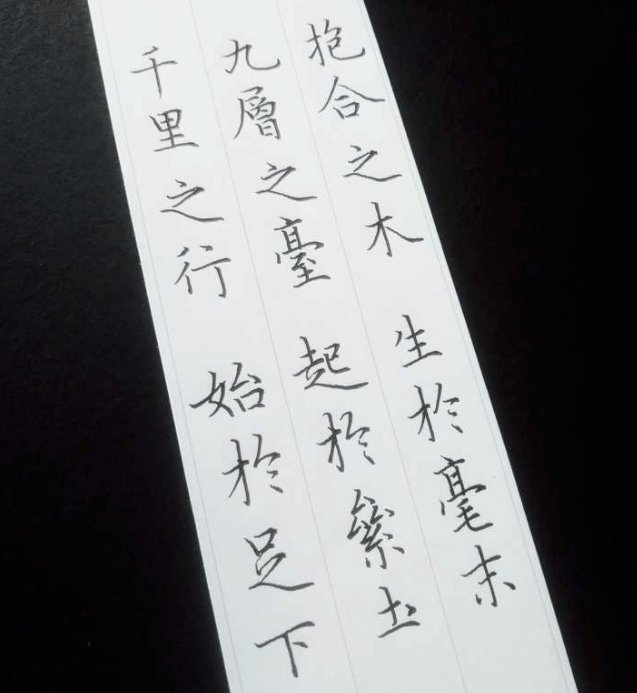Learning calligraphy for a long time has given me a clear understanding of myself.

The longer I study calligraphy, the more important I feel that there is an issue - we aim to catch up with the ancients and use their relics as models, but we often ignore that we are in a completely different era from the ancients.
This "different eras" does not refer to the Tang and Yuan dynasties, Wei, Jin and Song dynasties, but ancient and modern times.
From a calligraphy learning perspective, this is an important difference.
The foundation of art is technique. If you don't hone your skills to a certain extent, no matter how much you say, it will be nonsense. If you want to create excellent calligraphy works, first of all, your hand must control the brush to a "free" level. At this point, the ancients' advantage over us is unimaginable.
The daily writing tool of the ancients was a brush. For them, writing with a brush was not about "learning the brush" or "writing big characters", but about keeping accounts, writing letters, and doing homework...
In "Wulin Gaiden", whenever Mo Xiaobei made a mistake, Tong Xiangyu punished her by copying ancient Chinese prose, "Three Character Classic" 10 times, "Encouraging Learning" 50 times, and "The Analects" 100 times... When I saw these plots when I was a child, I just felt that Xiaobei was really pitiful. Many years later, when I saw the scene of Xiaobei copying books with a brush, I suddenly felt a chill running down my spine and quickly turned off the computer to write the post.
For calligraphy learning, when times change and we pick up pens, pencils, and gel pens, there is a rift between us and the ancients. Now, this rift has become very big, and it may become even bigger in the future. As it gets bigger, this crack determines that we have an "innate disadvantage" in calligraphy learning compared with the ancients.
After all, technique is the foundation. When the foundation reaches a certain level, it is aesthetics and thought that determine the height of the work.
As a traditional art, calligraphy is closely connected with Chinese culture and aesthetics. Historically, with the changes of dynasties, each period has its own calligraphy ideas and aesthetic ideas - the Wei and Jin Dynasties were free and easy, the Tang Dynasty was strict, The Song Dynasty promoted the idea of interest, and the Qing Dynasty’s stele study rose...
But one thing that cannot be ignored is that these different ideological propositions and aesthetic pursuits are all integrated into the large system of "Chinese traditional thought and aesthetics".
I do not deny that the current era has its own thoughts and aesthetics, nor do I think that the ancients’ thoughts were deeper than ours, nor do I think that the ancients’ aesthetic standards are necessarily better than ours.
I just often think that if the information in Mi Fu's brain is extracted, it should be like this:
"The painting with Huai Su's calligraphy I saw the other day was really nice. I'm going to ask about the price when I get paid next month."
"This newly delivered coral pen stand is very high-end. I have to draw it."
"I got a new piece of ink, so I have to write it down."
"I'm going to Tiaoxi. I'll be happy and write two poems."
"Spring is here, write two poems."
"Summer is here, write two poems."
"Autumn is here, write two poems."
"It's really cold in winter, so instead of writing poems, let's design two seals..."
And if the information in my brain is extracted, what should it look like?
"Mi Fu writes so well, idol!"
"Bob Dylan is awesome."
"Xiaomi's design has finally reached the forefront of the world."
"Giacometti is also very good."
"Order takeout. Tsk. This UI is so ugly."
"Let's engrave two seals..."
As a person with limited knowledge, I don't want to talk about "the cultural gap between contemporary China and ancient China" or "the impact of globalization on Chinese people's aesthetics"... I just sometimes can't help but imagine, if I were asked Traveling back to the era of Mi Fu and Su Shi in the form of an embryo, and being immersed in such an ideological and aesthetic environment since birth, will I also become a great "ancient calligrapher"?
At least, it will be easier than now...
After thinking more about these messy things, I suddenly realized that I have a rare advantage, that is, as a calligraphy student, I can stay awake and see my situation clearly——
There are inherent disadvantages in the cultivation of techniques compared to the ancients, and the general aesthetic environment is completely different from that of the ancients, but we must write "calligraphy works that are not inferior to the ancients in terms of level and style."
This is almost perverted. . .
After seeing this clearly, I no longer think that people who learn calligraphy today can become masters by keeping their natural state and writing casually like the ancients. The final state to be reached may be "calligraphy comes out of nature", but the process is definitely not ——Because our situation determines that we must have a learning attitude and method that adapts to this situation.








